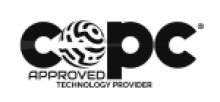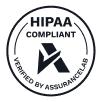You might have the best knowledge management system in the world, but without an effective governance framework no one will use it.
This is regardless of technology and features. Why? Knowledge management governance is about the maintenance of the content in your KMS. It’s about keeping content relevant, timely, and compliant.
Without the right processes in place—processes for authoring, changing, and reviewing content—your knowledge will eventually become unusable due to loss of quality.
In our view, successful governance—the kind that keeps users coming back for answers because they find the system helpful—is more about how well your organization promotes knowledge as a strategic asset than about factors like technology.
Case in point: you can implement the best KMS on the market and things will probably run fine by themselves for a while. But if no one is accountable for the content, or if you allow anyone to update content as they like, then the answers are likely to lose their quality and become less relevant over time.
So how do you develop the necessary governance framework that’s a prerequisite to implementing sound knowledge management?
Before digging into this question we want to mention one observation. Working with customers of varying sizes and industries over the years has shown us that governance isn’t just for large companies, or for those of a minimal knowledge management maturity level.
Anyone who’s considering leveraging organizational knowledge should develop a knowledge management framework to lay out the policies, roles, and procedures for maintaining the integrity of knowledge throughout its lifecycle.
Below, we’ll show you the key parts of knowledge management governance in a customer service environment and describe:
- Our approach to getting started with knowledge governance.
- Governance features that a customer experience knowledge management system should have.
Ready to explore an enterprise knowledge management system that is best in class? Book a trial with livepro today.
Getting Started with a Governance Framework
Previously we mentioned that knowledge governance is more an organizational than a technological issue—though technology plays a supporting role.
Setting up a comprehensive governance framework requires you to look at your current knowledge processes and define objectives.
In essence, it’s about asking the right questions.
In the next sections, we identify four main areas in which to focus your initial efforts in setting up a structured framework:
- Your content, i.e., organizational knowledge
- Announcements and communications that impact your content
- Feedback on your content
- Reporting about your content and its usage
Within these areas, we recommend first asking key questions before moving on to define roles, policies, and procedures for governing your knowledge operations and decision-making processes.
Knowledge and Content
Considering the content in your system as a strategic asset whose value will keep users coming back means establishing clear rules for creating and managing it—in accordance with your organization’s needs and applicable regulations.
Before implementing a knowledge management system we recommend you answer the following key questions:
- What is your process for content creation and update requests?
- Who can request new content and updates? How will you let them do this?
- What service level agreements (SLAs) or time frames will be in place to get this implemented, including reviews?
- Who are the subject matter experts (SMEs) or approvers of content?
Announcements and Communications
Announcements about updates or changes to a policy or procedure are a big part of governance, and keep users aware of knowledge management practices.
Key questions concerning announcements should include:
- What’s the process going to be for people to request an announcement?
- Who can make the request?
- What are the timeframes for completion from an authoring and review standpoint?
- Who are the SMEs and approvers for the announcements?
- What is the process and timeframe for urgent announcements?
Feedback on Content
Feedback on the usefulness of content helps build users’ trust in the KMS. Not only does feedback encourage and maintain engagement (via collaboration and sense of ownership), but the insights gained can highlight gaps, inconsistencies, or outdated information.
When considering how users will leave feedback you should ask the following:
- What is the process going to be when responding to feedback?
- What are the timeframes to respond to feedback and keep users updated?
- What or who are the escalation points (SME or approver) for feedback?
- Who is responsible for managing or maintaining the feedback?
Reporting on Content Usage
Understanding usage trends across different teams and departments, and identifying key areas for improvement allows you to make the necessary adjustments to elevate the usefulness and relevance of your knowledge management system.
Leading questions are:
- What is the process for making reports? Who will you give these access to?
- Who can make the request?
- What are the timeframes for creating reports?
- What does the monthly reporting schedule for governance look like?
5 Knowledge Governance Features to Look For in a KMS
KMS features should automate knowledge operations (e.g., the capture, management, dissemination, and measurement of knowledge). This streamlines processes while achieving higher accuracy and consistency, not to mention reducing staff workload and improving traceability for audit purposes.
At base you should consider a KMS that has the following five features supporting governance:
1. Knowledge Ownership
Successful knowledge management requires accountability, which in KMS terms means knowledge ownership.
It’s fine and good to restrict editing of knowledge objects to a few qualified experts, but if no one is accountable for those changes then you may invite potential errors and inconsistencies.
In many customer service organizations we work with, knowledge owners are typically those working in product departments, while subject matter experts (SMEs) are only allowed to suggest changes—notwithstanding their expertise.
This is because product owners are typically better informed and up-to-date regarding product changes, and thus are better positioned to assume responsibility for changes to the content.
A customer service knowledge management system should allow you to clearly designate who owns the knowledge and who can ultimately approve of changes:
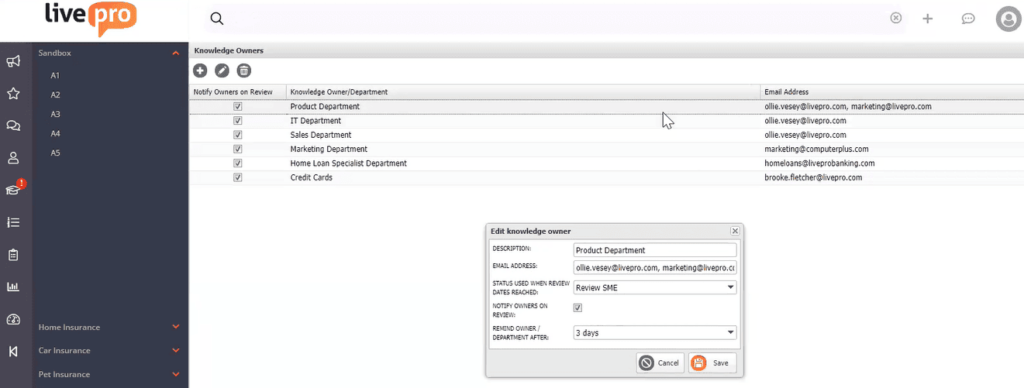
2. Content Workflows
Since content creation and management are the core activities of a KMS, these should offer structured processes for creating, reviewing, approving, and publishing content within the system.
Workflows ensure that content gets validated via a predefined sequence of actions and approvals.
The automation aspect of workflows means the KMS handles routing of notifications and versioning, which streamlines collaboration and allows staff to focus on customer engagement.
When designing workflows you typically assign system roles to key users (e.g., knowledge owner, author, reviewer, etc.), which should already have been defined by your governance framework.
A customer experience knowledge management system like livepro offers advanced workflow design capabilities, along with management of system roles and their scopes:
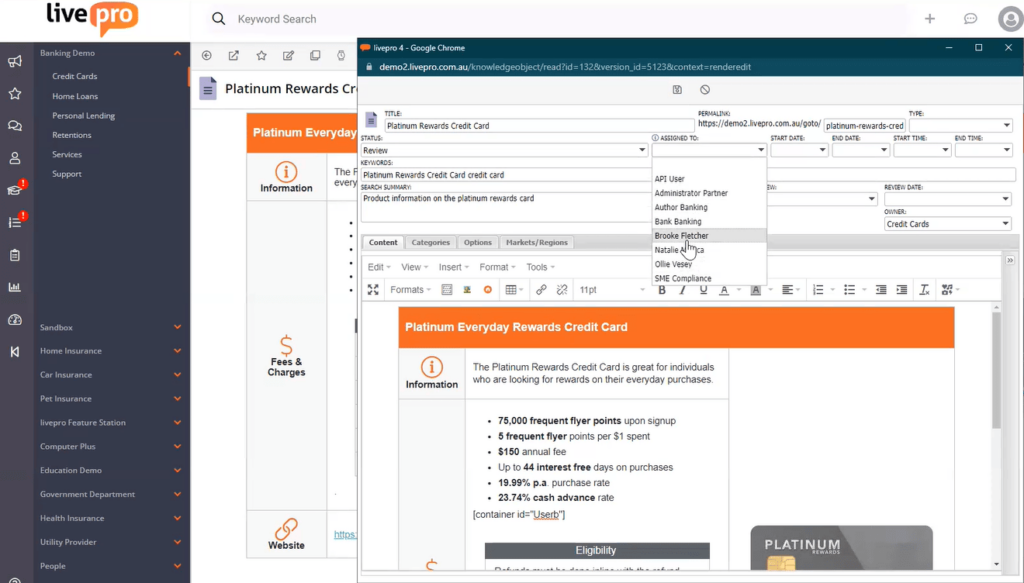
3. Announcements
Your KMS should enable creation of announcements and specify who receives these by means of a distribution list.
We recommend additional features such as the ability to show what’s urgent and what’s not, and to mark announcements as read or unread:
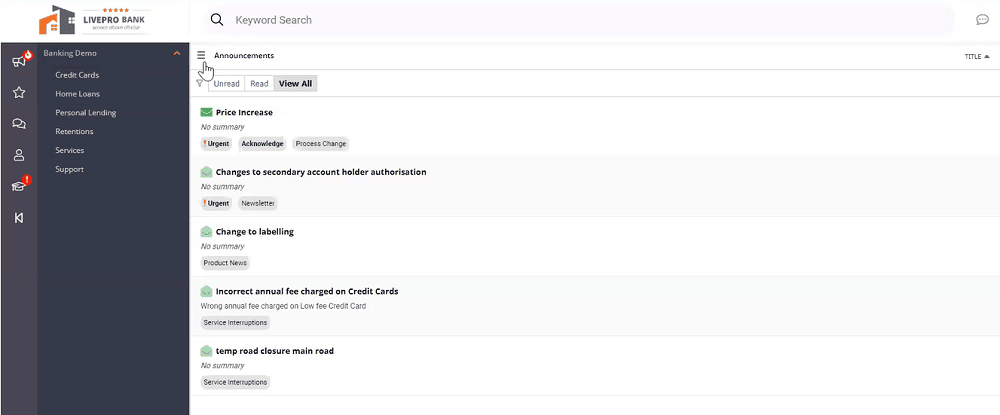
4. Feedback
Your system should make it as easy as possible for employees and customers alike to leave feedback on content.
Not only should users be able to rate the usefulness of a piece of content (say, from one to five stars), but they should also be able to leave detailed feedback. For example, a customer service representative who gets off a call with a customer might note that a procedure requires an extra step.
In this case, the KMS should offer a workflow allowing a user to submit detailed feedback and have this routed to the correct knowledge author or owner for review and possible inclusion.
Such workflows and their resulting actions should also be archived for a period of time for compliance and auditing purposes.
5. Reporting
A KMS reporting feature should offer both detailed usage analytics and the ability to create a variety of views on data about the content in your system.
A good use of reporting is to find knowledge gaps. For instance, to uncover user searches that didn’t get any results. Or to check how often users access a piece of information—e.g., does the lack of access mean poor communication regarding the information?
You should also be able to run certain reports automatically at periodic intervals (e.g., daily, weekly, monthly, etc.) and send these out to key stakeholders as necessary
livepro offers some of the most extensive reporting in the industry, offering scores of different reports out of the box to help you keep the content in your system current and up-to-date:
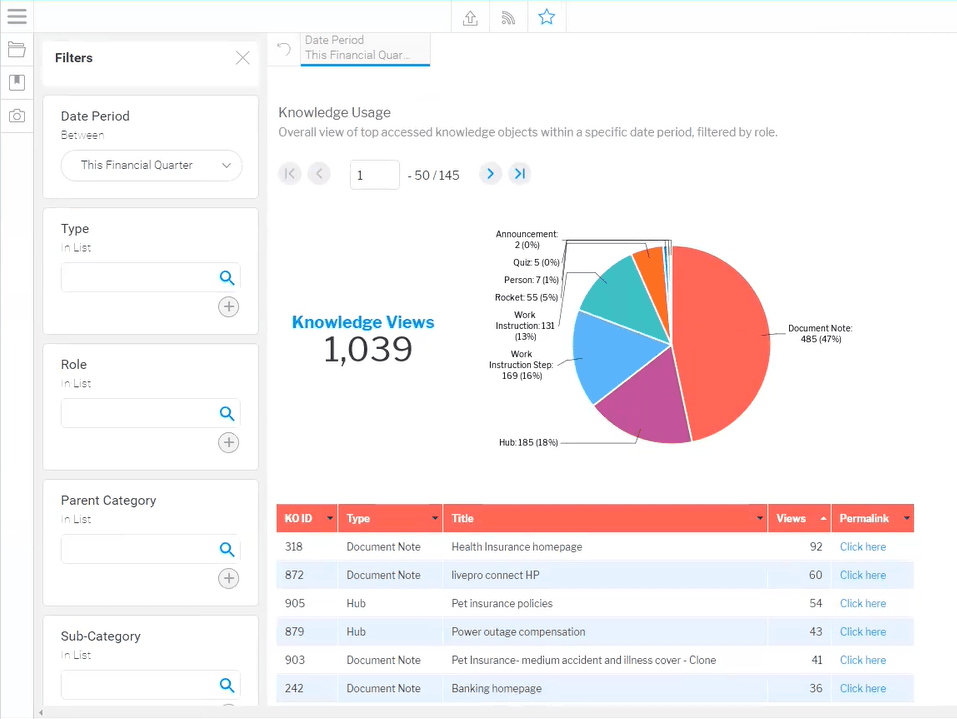
Conclusion
As a knowledge management system that’s purpose built for customer service in regulated industries, knowledge governance is at the core of livepro.
But knowledge management governance is more than about features. It first requires an assessment of knowledge practices in your organization, as well as decisions on how these practices will be implemented in the future.
Our team has extensive experience in successfully guiding organizations in knowledge governance, so please don’t hesitate to reach out if you have queries or assistance regarding your knowledge initiatives.








